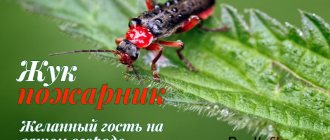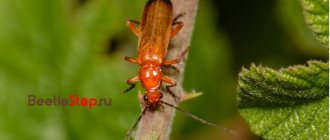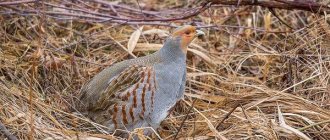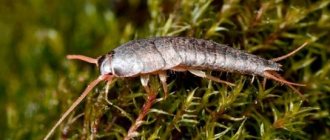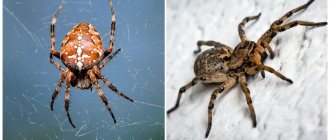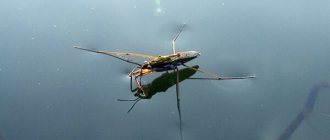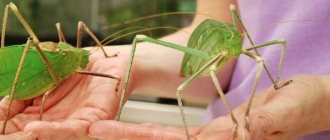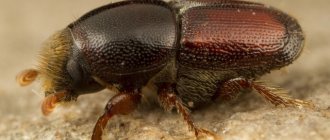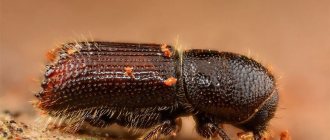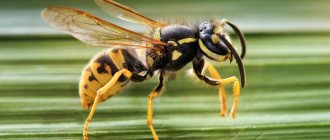- Who is the skin beetle?
- The carpet beetle bites
- Types of carpet beetles Kapra beetle
- Spotted leather beetle
- Ham skin beetle
- Fur coat beetle
- Carpet beetle
- Brown leather beetle
- Smirnova beetle, Frisha, flower beetle
Eaten fur coats, boots, jackets, furniture chewed through labyrinthine passages and many other damaged things in the house. This is due to an unfamiliar tenacious and voracious beetle - the fur coat beetle. This is a common and dangerous pest that lives in apartments and houses and is difficult to get rid of.
Who is the skin beetle?
Nature is inhabited by 600 species of leather beetles, which are classified as coleopteran insects. 7 species are dangerous pests.
The bugs are not small - the body length is 0.3-1.2 cm, on which hairs or stripes are visible. Color black, brown or spotted. The speed of movement is low, it flies weakly, if you touch the bug, it will turn over with its paws up. The voracious brown larvae are covered with long hairs.
Skin beetles are attracted to human housing by dry air, available food and polluted premises. The food of skin beetles is animal and plant organic matter; they easily chew through paper and plastic packaging. In human homes, bugs feed on natural fabrics, wood and food scraps.
The “children” of the leather beetle eat non-stop, feeding on fur, down and leather, wool, silk and felt. They chew books, cables, and feed on wallpaper and parquet. These insects are carriers of infection, parasitic worm eggs, and also bite, leaving red spots on human skin.
Insect species
The stink bug family is characterized by brightly colored, medium to large sized ground bugs with flat, scute-like backs. Of the varieties, the families of true shield bugs, earthen, hemispherical, woody or berry, turtle shield bugs and many others are known.
- The family of true shield insects has up to 4,000 species, the size of insects is from 0.8 to 1.8 cm, and more than 200 species live on European territory. Of the varieties of this family, the lined scale insect stands out with its bright color. He was nicknamed the Italian bug for his red back with black stripes, similar in color to the uniform of the Vatican guards.
- The earthen shield family has more than 700 species, lives on the surface of the earth, feeds on roots and is harmful to some types of cereals and peanuts. The family of hemispherical shield bugs includes more than 500 species, ranging in size from 0.2 to 2 cm; representatives have a rounded shell reaching to the abdomen.
- The family of shield turtles is small in number, numbering no more than 100 species. An insect ranging in size from 0.6 to 1.5 cm. They are considered the most powerful agricultural pests, live in fields, and feed on plant sap.
- Wood bugs are a family of no more than 200 species. The size of the insect can be from 0.5 to 3.5 cm. They live on trees and shrubs, feeding on foliage. The most famous varieties are the green and gray wood stink bug and the berry stink bug.
- The gray stink bug is a small bug, 0.5 to 0.8 cm long. Habitat: trees such as birch, beech, holly, alder, spruce. The green shield bug or berry bug is a large insect up to 3.5 cm long, lives on trees and shrubs, often in raspberry fields, feeds on the juice of leaves and berries. It is considered a pest of agricultural crops.
The picture shows the types of bedbugs:
- edge worker;
- sharp-headed shieldbill;
- Italian stink bug;
- green tree shield;
- subcorn;
- smoothie;
- predator;
- shield catatacanthus incarnatus;
- bed bug;
- streaked rower;
- ranatra;
- sea water strider;
- shieldweed "senator";
- water bug;
- stink bug Chrysocoris silatus;
- edge worker;
- skinny bug;
- water scorpion;
- soldier bug.
Wood bug
The wood bug has a large, flat body. Coloring
the insect depends on the time of year: in summer it is light green, merging with the green of summer foliage; closer to autumn, the green color is diluted with brownish-brown spots, and at the height of autumn the insect merges with the crimson-orange color of autumn trees.
In the back of the body, brown wings are hidden under the shield, which the bug does not use very often. Its wings have a small span and insufficient strength for the insect to take off easily, so getting into the air is a very energy-consuming task for the bug.
The stink bug makes flights only when it is necessary to search for new food.
The carpet beetle bites
The bite of the skin beetle is painful and often dangerous - infection with parasites. For people with sensitive skin it will appear as bright red spots, for others it will appear as small harmless dots. The larvae spread the viral infection wherever they crawl. To get rid of it, you need to clear the room of both the bug and the eggs.
Skin beetle bites are painful for children and women. If a skin beetle has bitten you, use a disinfectant or hydrogen peroxide or alcohol to treat the bite site. An allergic reaction is relieved with an antihistamine. For quick healing, use a moisturizer if there is no infection. If inflammation appears, you should see a doctor.
Ladybugs family
Even small children are familiar with these cute little bugs. They are well known for their lack of fear of humans and their bright red coloration.
The best known is the seven-spotted ladybug (a red beetle with black dots), although their species diversity is enormous.
In total, there are 5,200 species in the world in the family Ladybugs, in the order Coleoptera. This means that their relatives are numerous species of beetles. Some individuals are red with black dots, others have irregularly shaped spots instead of dots, and others are black with red spots. Very rare, but there are ladybugs of the same color, with a black color.
Types of skin beetles
To recognize the dangerous pests in the bugs crawling around your apartment, it is worth learning about the common types of skin beetles.
Kapra beetle
The nylon beetle (also called the grain beetle) has a 3 mm oval brown body and light hairs. The 5 mm larvae have red-brown hairs. For habitat it chooses cereals, nuts and dried fruits, loves meat and cheese products. The beetle is a carrier of infection. Lives more often in warm climates.
Spotted leather beetle
The spotted beetle is a leather beetle with an elongated light brown body of 9 millimeters. The larvae have a brown back, reddish-brown head and hairs.
The spotted skin beetle chooses the corpse of a mammal to live in; these bugs clean the bones for the museum. In the apartment, the larvae eat meat, fish, cheese, and milk powder.
Ham skin beetle
Ham skin beetles are oblong, a centimeter long, black in color with yellow hairs, and equipped with gray-yellow wings. The dark brown larvae have brown hairs on their bodies.
They choose open food products and do not refuse to chew wooden objects. The insect is prolific and easily penetrates living spaces.
Fur coat beetle
Harmless fur coat beetles choose dusty apartments because dust is food for them, just like human food. Doesn't eat fur coats. Oval, 6 mm body with a black head and chest, and brown elytra with white hairs or spots.
Carpet beetle
For 2-5 mm carpet beetle larvae, the treat includes carpets, dead human skin particles on bedding, crumbs, cat hair, as well as fur, skin and dust.
In addition, the larvae feed on feathers and down from pillows. The bug is brown or black in color; the adult insect uses up the reserve accumulated in the larval stage for life.
Brown leather beetle
The museum leather beetle, also known as the brownie, chooses indoor flowers and books for its habitat. Having settled in the museum, he chooses stuffed animals, leather book bindings, natural fabrics and paintings. Rarely found in residential areas. A beetle with an oval body of 3.5 mm, with black elytra and yellow hairs.
Smirnova beetle, Frisha, flower beetle
The 3 mm Smirnov beetle has a brown back. For living he chooses old wooden window frames and window sills.
Frisch's little black beetle rarely settles in apartments. If it appears, it chooses food.
The flower beetle is found on garden plants.
Reproduction
In winter, shield bugs hide in forests under fallen leaves and are in a state of suspended animation. With the arrival of spring, they leave their wintering grounds and fly to gardens, fields, and bushes to gain strength after winter and nourish themselves with plant sap.
After the recovery period, the period of mating and egg laying begins.
In the warm spring-summer period, stink bugs can lay eggs twice a season, which have the same soft green color as the insect itself. The eggs are attached very tightly to the back of the leaf and are arranged in even rows, reminiscent of beadwork. One clutch can contain about 100 eggs.
The egg looks like a barrel or a jug, it depends on the type of bug. On the empty egg you can see small teeth that held the lid until the larva hatched. The duration of the egg development stage depends on temperature conditions; usually the egg develops from a week to a month.
The larva hatched from the egg differs from the mature bedbug only in the absence of wings, and the color and shape of the larva and the adult bedbug are similar. A strong chitin shield prevents the larva from growing, so during the development process it sheds it five times. This is the most difficult stage of development for an insect. During this period, a large number of larvae fail to shed the shell that restricts their growth, and they die.
How the leather beetle gets into human housing
In warm weather, bugs secretly penetrate into the apartment, where it is often trashy and dirty:
- They fly into an open window or window;
- Hiding in purchased furniture from an infected room, clothes and shoes;
- With indoor plants or on a bouquet;
- Brought in by shoes or clothes when coming from the street;
- Food contaminated with larvae is brought into the apartment;
- They will crawl from the balcony, use cracks, ventilation or garbage chutes.
Distribution, features
Ladybugs are distributed throughout the world. They live on all continents of the world except Antarctica. Ladybugs inhabit open spaces with herbaceous vegetation - gardens, meadows, forest edges, steppes, and less often - forests. They form clusters only during the winter, but otherwise live alone. In search of food, they crawl along the leaves and stems of plants, and can also fly over long distances.
The peculiarity of these beetles is that when threatened, they secrete a rather sharp-smelling, poisonous yellowish liquid that scares away enemies. Only a few species of these beetles are harmful to crops. The rest (predatory species) destroy scale insects, aphids, psyllids and other pests of garden and garden crops.
The ladybug is not always a red beetle with black dots (the photo demonstrates this). Some of the varieties have a yellow outfit with black dots, others are black with red dots. There are even white ladybugs! These are all young beetles that have recently emerged from the pupa. They acquire their normal adult colors several hours after birth.
How does the skin beetle reproduce and develop?
The development of the larva to an adult insect lasts 12 months.
The female beetle lays eggs in cracks and on top of objects 5 times a year, over 100 eggs in a lifetime. The larvae hatch in 2-50 days, this is influenced by dry air and temperature - the warmer and drier, the sooner the appearance.
The larva molts 6-7 times in 5-9 days, then becomes a pupa, from which an adult insect emerges. This takes 60-90 days. Before pupation, the larvae gnaw out 10 cm labyrinthine passages in inedible objects.
It is interesting that with the onset of unfavorable conditions, the larvae fall into torpor for up to 4 years, and upon emergence they continue to develop. Adult beetles can spend the same amount of time without feeding and still reproduce.
Garden pests
We have already written in detail about the pests of each specific garden crop: about the “enemies” of potatoes, cabbage, beets, and parsley. And also about effective methods of combating them.
- All garden pests in tables with descriptions, photos and control measures
We have compiled a “dossier” for you on each pest - save this collection!
But there are also polyphagous garden pests - insects that can damage and destroy plants from different families. Such pest beetles are the most dangerous (we agree that for the sake of brevity, under the conventional name of beneficial and harmful “bugs”, later in the article we will mean all arthropod inhabitants of the garden, specifying their species if necessary).
These are, for example, aphids - cotton and potato. They feed on plant sap, while secreting thick honeydew (honeydew), interfering with the normal functioning of plants. In addition, many of their species are capable of spreading diseases in the form of viruses and promoting the formation of various pathological anomalies (such as galls) in plants.
These are a variety of beetles. For example, the well-known potato, pumpkin and eggplant pests, the Colorado potato beetle. Or the click beetle, which is not dangerous in itself - its wireworm larvae are harmful, devouring the tubers, roots and bases of the stems of many plants. Or kravchik (bighead), which “cuts” the leaves and young shoots of corn, sunflowers and other vegetables.
This is a spider mite that covers the foliage of many vegetable crops with a thin film-web, which prevents the plant from growing and functioning normally.
These are various cutworms, holey leaves, and sometimes stems of tomatoes, onions, cucumbers, potato tubers, carrots and beets.
These are leafhoppers (slobbering pennies) that destroy the leaves and ovaries of almost all garden plants.
These are thrips, whose activity leads to withering of plants and deformation of their fruits.
These are miners that dig oblong tunnels in the leaves of legumes, cucumbers and tomatoes.
These are whiteflies - greenhouse, tobacco, etc. - whose work is visible in the beds in the form of yellowed, spotted, withered, and then fallen leaves.
This is a terrible mole cricket, from which all summer residents groan, watching how a huge insect digs tunnels in the soil in the garden, simultaneously gnawing all the underground parts of the plants encountered along the way.
- How to deal with mole crickets - effective drugs and folk remedies
Don’t know how to get rid of mole crickets on your property? Our recipes will help you protect your garden crops from this underground pest.
Is it true that the above is already enough to seriously concern yourself with the health and safety of your garden?
Of course, harmful insects can be successfully controlled using chemical methods, but this article will discuss another possibility. Let's take a look at the “bright side of the force” and find out how you can save yourself from dangerous “bugs” with the help of their relatives - insect predators and parasites. It turns out that it is often cheaper and more effective.
How to get rid of the leather beetle
It is difficult to fight the beetle because it is tenacious. If it appears, you will have to check rooms and objects for many years, taking preventive measures.
Physical method:
- vacuum cleaner daily, cleaning or replacing the bag; it is better if the vacuum cleaner has a water filter;
- carry out general cleaning with a special disinfectant;
- treat surfaces and hard-to-reach places using a steam generator;
- open windows in winter 2 times a week;
- throw away heavily contaminated items or freeze for 4-5 hours, boiling and washing are allowed;
- clean carpets and upholstered furniture.
Carpet beetles do not like the smell of lemon balm, tansy and lavender.
Chemicals against skin beetle
Powdered boric acid or Borax treatment. The same drugs, in bags, are laid out between clothes on shelves for 4 hours, placed in pockets. It is useful to add "Tetrix" or "Executioner". Then the things should be washed and dried.
From aerosols they are treated with “Dichlorvos”, “Difox” or other spraying agents, applying after 1.5-2 weeks.
Anti-moth preparations are used as an additional remedy.
Use a fumigator.
Using Velcro traps or the pharmaceutical product “Parmethrin”.
Description of the ladybug
These are small red beetles with black dots (photo can be seen below) with a rounded, convex body. The lower part of their body is completely flat. Their usual coloring is red, black and yellow in contrasting tones. The head is small. thin, black. Body length is 5-8 mm.
In sunny weather, these heat-loving insects are active: they crawl hastily, quickly take off and land on plants again in search of food. Their flight is very easy, fast and silent.
Typically, the victims of ladybugs are sedentary insects, and therefore hunting for them involves only eating the victim.
Preventive measures
Simple rules will prevent the arrival of skin beetles. First of all, close the places where insects enter, and pack items made from natural fabrics and fur. Hide bulk products under sealed lids. Treat waste collection areas and pet hair.
Wash clothes regularly, wash floors using a disinfectant or vinegar, and clean carpets with hot steam. Throw away or burn damaged items. Inspect cabinets, inside bedside tables, and the bottom and back of furniture more often.

